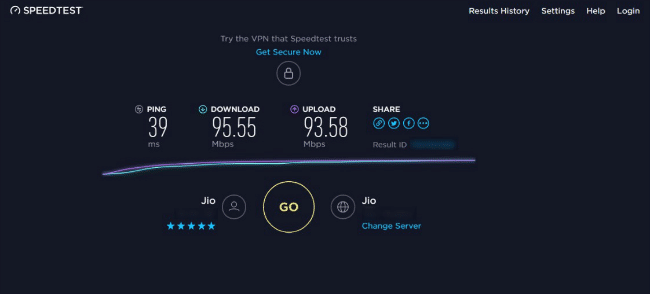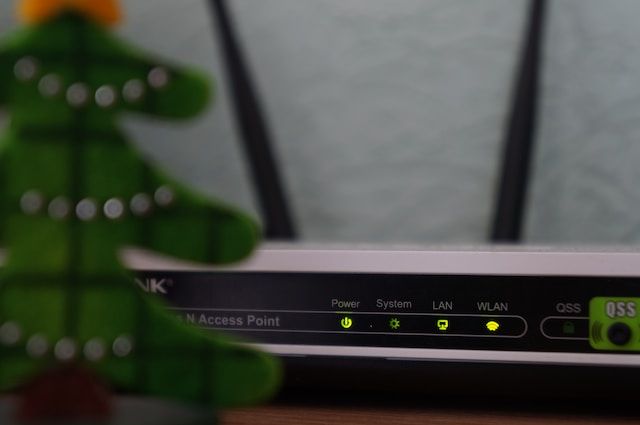
Jio has officially launched its AirFiber services in India. The company aims to bring a broadband-like internet experience across the country, without the need to install any underground wires. Jio’s AirFiber can offer speeds up to 1 Gbps and also comes with bundled OTT subscriptions.
Does that make the Jio AirFiber the next big internet revolution in India? Is it time to leave behind your traditional broadband internet? Let’s have a look to find the perfect fit for you between JioAirFiber and regular broadband services.
How Does Jio AirFiber Work?
The Jio AirFiber makes use of Fixed Wireless Access (FWA) technology on the 5G network. Here, Jio provides you with a WiFi router that connects to an Outdoor Unit (ODU). This ODU establishes a stable link connection between the tower and your router. It is similar to DTH, where the STB in your house is connected to an external antenna, which is fixed outside your house.
The router can then be used to connect your devices using WiFi or Ethernet and enable high-speed internet. A single ODU unit can be used to power 8 individual Jio AirFiber users.
How is Jio AirFiber different from JioFi Hotspot Device?

The concept of the Jio AirFiber is similar to that of JioFi, where an external device connects to a cellular tower, and supplies internet to you using WiFi. However, JioFi is only limited to 150 Mbps, with multiple drawbacks in terms of the WiFi range, battery life, and internet stability.
The AirFiber on the other hand, uses an advanced and fully-fledged router capable of speeds up to 1 Gbps. As it is a router, you can also connect devices using ethernet and enjoy wider WiFi coverage. The Jio AirFiber also comes with larger antennas to receive cellular signals, as compared to the tiny receptors on the JioFi. You can notice that there is a generational gap in technology between the Jio AirFiber and JioFi.
Jio AirFiber vs Broadband: Which Is Better for You?
Jio’s AirFiber has added a new convenience for internet users as it brings forth high-speed internet connection without any additional setup. But is it good enough for you to replace the tried-and-tested broadband technology? Let’s compare Jio AirFiber and broadband internet across factors such as speed, reliability, latency, and most importantly, running cost.
Jio AirFiber vs Broadband: Speed Comparison

The Jio AirFiber offers maximum internet speeds up to 1 Gbps. The speeds can go even faster, as Jio AirFiber uses 5G networks along with WiFi 6, both of which are rated for speeds of up to 1.5 Gbps. So in the future, Jio may launch newer plans with higher internet speeds on the AirFiber.
For broadband, we have two types of connections: twisted pair and optic fibre. Now, most twisted-pair broadband connections are limited to a maximum of 100 Mbps speeds. While optic fibre connections can go as fast as 1 Gbps. So if your broadband ISP is using twisted pair connections, without any fibre options, then the Jio AirFiber would be a better fit for you.
However, if you have access to fibre connections, then speed won’t be a major differentiating factor for you with the AirFiber. Hence, you should look for other factors beyond speed.
Jio AirFiber vs Broadband: Reliability
In an era where we are moving away from cables, such as the switch towards wireless headphones, bluetooth keyboards, we have still retained using wired broadband connections in our daily lives. This is because no matter how advanced wireless technologies we develop, wired connection is still the most reliable medium for transferring signals.
Let’s understand this from an example. Consider that you have to transfer water from point A to point B. You have two options: using a pipe from one end to another, and the other option is to create a water trajectory in the air.
Now, it is understandable that using a pipe is the most efficient way to move the water, as it ensures almost zero wastage. However, when you create a water trajectory in the air, no matter how perfectly you do it, you will end up spreading a few drops in the air, causing wastage. Just like how the pipe channelizes the flow of water with maximum efficiency, wired connections are always superior to wireless connections for efficient data transfers.

As the Jio AirFiber uses wireless transmission, it is susceptible to signal losses because of factors like weather, distance from the cellular tower, and signal obstructions because of walls and other obstacles. Wired broadband connections on the other hand are unaffected by these factors, with the only risk of being the wire getting damaged, which in most cases is a quick fix.
Jio AirFiber is not bad for reliability. Jio has a solid network penetration of 5G connectivity across the country, making it a stable choice to consider. But, if you live in an area which is susceptible to weak cellular networks because of the local geography, then a wired broadband connection will prove more reliable for you.
However, if you have ample network reception even in the densest corners of your house, then the Jio AirFiber will be as good as wired broadband for reliability.
Jio AirFibre vs Broadband: Latency
Latency is one of the biggest differentiating factors between the Jio AirFiber and broadband connection. Jio says that their 5G networks offer ultra-low latency because of the Standalone 5G infrastructure used by them. And it is true, the latency on Jio’s 5G network is much better than its 4G counterparts, making it ideal for broadband usage.
On average, Jio 5G has a latency of 11ms in India. So if your internet usage involves heavy downloads, video streaming, and Live TV, you won’t notice any difference in latency between Jio AirFiber and wired broadband.
However, if you a gamer – and every millisecond matters to you – then you should reconsider your choice and prefer a wired connection. The wireless nature of Jio AirFiber will always result in a fluctuating latency range, which is not recommended for gaming.
Jio AirFiber vs Broadband: Cost of Running
The cost of running the internet connection is an important factor in making the choice between the two. Since wired broadband charges in India vary by city, we are going to compare the monthly charges of Jio AirFiber directly with Jio GigaFiber for illustration purposes.
| Speed | Jio GigaFiber | Jio AirFiber |
| 30 Mbps | Rs 399 | Rs 599 |
| 100 Mbps | Rs 699 | Rs 899 |
| 300 Mbps | Rs 1499 | Rs 1499 |
| 500 Mbps | Rs 2499 | Rs 2499 |
| 1 Gbps | Rs 3999 | Rs 3999 |
Jio GigaFiber also has an installation cost of Rs 1500 as a one-time fee. However, there are ZERO installation or setup charges for Jio AirFiber.
If we compare the plans, Jio AirFiber is 25% more expensive than wired broadband for the 30 Mbps and 100 Mbps plans. As we move up the bandwidth ladder, the costs are at par for Gigafiber and AirFiber.
However, it is a matter of fact that the majority of users in India will be using the 30 Mbps and 100 Mbps plans, which makes AirFiber more expensive than wired broadband.
Despite initial installation costs, wired broadband is still cheaper than Jio’s FWA-based AirFiber. Also, Jio GigaFiber pricing is on par with the market rates of all other wired broadband service providers in India. Hence, if price is a deciding factor, then a wired broadband connection will be more suitable for you.
Jio AirFiber vs Broadband: OTT Bundles
Jio also bundles OTT subscriptions with both, Jio AirFiber and JioGigaFiber. So if you are choosing between Jio AirFiber and Jio GigaFiber, then this can be a good differentiating factor between the two. This may not be applicable if you are comparing the Jio AirFiber to a local broadband service, as your local ISP is unlikely to bundle OTT subscriptions.
The Jio AirFiber offers OTT bundles even on the lowest plans, starting with 30 Mbps. However, Jio GigaFiber only bundles OTT on plans above 150 Mbps.
| Speed | Jio GigaFiber | Jio AirFiber |
| 30 Mbps | – | 14 Apps |
| 100 Mbps | – | 14 Apps |
| 300 Mbps | 14 Apps + Netlfix, Amazon Prime, JioCinema Premium |
14 Apps + Netlfix, Amazon Prime, JioCinema Premium
|
| 500 Mbps | 14 Apps + Netlfix, Amazon Prime, JioCinema Premium |
14 Apps + Netlfix, Amazon Prime, JioCinema Premium
|
| 1 Gbps | 14 Apps + Netlfix, Amazon Prime, JioCinema Premium |
14 Apps + Netlfix, Amazon Prime, JioCinema Premium
|
List of 14 Apps: JioCinema, Disney+Hotstar, SonyLiv, Zee5, Universal+, Lionsgate Play, Sun Nxt, Hoichoi, Discovery+, Shemaroo Me, Alt Balaji, Eros Now, Epic On, Docubay.
The higher cost of the Jio AirFiber on the most popular 30 Mbps and 100 Mbps are being compensated by Jio with a subscription to 14 different OTT apps. So if these subscriptions are useful for you, then the base plans of the Jio AirFiber make a great deal for you, as compared to the Jio GigaFiber, or any other local wired broadband service.
Jio AirFiber vs Broadband: Verdict
Jio AirFiber is better suited for those users who do not have access to good wired broadband connections. If you are a resident of a society that does not allow external ISPs, leaving you locked with an unsatisfactory broadband provider, then the Jio AirFiber is a perfect fit for you.
However, if you already have access to a fibre connection, or any other wired broadband with at least 100 Mbps speed, then it is better to continue with wired broadband because of its lower cost and better reliability. If the wired broadband costs in your locality are significantly higher than Jio AirFiber’s prices, then it might be a good idea to switch to the AirFiber, unless you are a gamer.
















